Contribution to the Physical Modelling of Single Charged Defects Causing the Random Telegraph Noise in Junctionless FinFET
Abstract
1. Introduction
2. Modeling and Simulation Procedure
3. Simulation Results and Discussions
4. Conclusions
Author Contributions
Funding
Conflicts of Interest
References
- Kaczer, B.; Franco, J.; Weckx, P.; Roussel, P.J.; Putcha, V.; Bury, E.; Simicic, M.; Chasin, A.; Linten, D.; Parvais, B.; et al. A brief overview of gate oxide defect properties and their relation to MOSFET instabilities and device and circuit time-dependent variability. Microelectron. Reliab. 2018, 81, 186–194. [Google Scholar] [CrossRef]
- Kang, C.J.; Buh, G.H.; Lee, S.; Kim, C.K.; Mang, K.M.; Im, C.; Kuka, Y. Charge trap dynamics in a SiO2 layer on Si by scanning capacitance Microscopy. Appl. Phys. Lett. 1999, 74, 1815–1817. [Google Scholar] [CrossRef]
- Sriram, S.R.; Bindu, B. Analytical modeling of random discrete traps induced threshold voltage fluctuations in double-gate MOSFET with HfO2/SiO2 gate dielectric stack. Microelectron. Reliab. 2019, 99, 87–95. [Google Scholar]
- Toh, S.O.; Liu, T.J.K.; Nikolic, B. Impact of Random Telegraph Signaling Noise on SRAM Stability. In Proceedings of the 2011 Symposium on VLSI Technology—Digest of Technical Papers, Honolulu, HI, USA, 14–16 June 2011; pp. 204–205. [Google Scholar]
- Kao, T.H.; Chang, S.J.; Fang, Y.K.; Huang, P.C.; Wang, B.C.; Wu, C.Y.; Wu, S.L. Investigation of low-frequency noise of 28-nm technology process, of high-k/metal gate p-MOSFETs with fluorine incorporation. Solid-State Electron. 2016, 115, 7–11. [Google Scholar] [CrossRef]
- Javier, D.; Javier, M.; Rosana, R.; Rafael, C.; Elisenda, R.; Francisco, V.; Fernandez, M.N. A smart noise- and RTN-removal method for parameter extraction of CMOS aging compact models. Solid-State Electron. 2019, 159, 99–105. [Google Scholar]
- Asenov, A.; Balasubramaniam, R.; Brown, A.R.; Davies, J.H.; Saini, S. Random Telegraph Signal Amplitudes in Sub-100 nm (Decanano) MOSFETs: A 3D “Atomistic” Simulation Study. In Proceedings of the International Electron Devices Meeting, San Francisco, CA, USA, 10–13 December 2000; pp. 279–282. [Google Scholar]
- Velayudhan, V.; Gamiz, F.; Martin-Martinez, J.; Rodriguez, R.; Nafria, M.; Aymerich, X. Influence of the interface trap location on the performance and variability of ultra-scaled MOSFETs. Microelectron. Reliab. 2013, 53, 1243–1246. [Google Scholar] [CrossRef]
- Contoyiannis, Y.; Potirakis, S.M.; Stavrinides, S.G.; Hanias, M.P.; Tassis, D.; Theodorou, C.G. Intermittency-induced criticality in the random telegraph noise of nanoscale UTBB FD-SOI MOSFETs. Microelectron. Eng. 2019, 216, 111027. [Google Scholar] [CrossRef]
- Shamsur, A.S.M.; Rouf, Z.Ç. Channel hot carrier induced volatile oxide traps responsible for random telegraph signals in submicron pMOSFETs. Solid-State Electron. 2020, 164, 107745. [Google Scholar] [CrossRef]
- Carlos, M.; Noel, R.; Francisco, G.; Akiko, O. Systematic method for electrical characterization of random telegraph noise in MOSFETs. Solid-State Electron. 2017, 128, 115–120. [Google Scholar]
- Angelica, L.; Andrew, R.; Brown, A.A.; Scott, R. Random telegraph signal noise simulation of decanano MOSFETs subject to atomic scale structure variation. Superlattices Microstruct. 2003, 34, 293–300. [Google Scholar]
- Gerrer, L.; Amoroso, S.M.; Hussin, R.; Asenov, A. RTN distribution comparison for bulk, FDSOI and FinFETs devices. Microelectron. Reliab. 2014, 54, 1749–1752. [Google Scholar] [CrossRef]
- Fan, M.L.; Yang, S.Y.; Hu, V.P.H.; Chen, Y.N.; Su, P.; Chuang, C.T. Single-trap-induced random telegraph noise for FinFET, Si/Ge Nanowire FET, Tunnel FET, SRAM and logic circuits. Microelectron. Reliab. 2014, 54, 698–711. [Google Scholar] [CrossRef]
- Rudenko, T.; Nazarov, A.; Barraud, S.; Kilchytska, V.; Flandre, D. A method for threshold voltage extraction in junctionless MOSFETs using the derivative of transconductance-to-current ratio. Solid-State Electron. 2019, 161, 107723. [Google Scholar] [CrossRef]
- Lee, C.W.; Ferain, I.; Afzalian, A.; Yan, R.; Akhavan, N.D.; Razavi, P.; Colinge, J.P. Performance estimation of junctionless multigate transistors. Solid-State Electron. 2010, 54, 97–103. [Google Scholar] [CrossRef]
- Miura, K.; Ino, T.; Tada, M.; Ohsaki, H. Shrinkage of atomic distances in ultrathin a-SiO2 film. Philos. Mag. 1992, 66, 25–36. [Google Scholar] [CrossRef]
- Hössinger, A. Simulation of Ion Implantation for ULSI Technology. Ph.D. Thesis, Technische Universität Wien, Wien, Austria, July 2000. [Google Scholar]
- Beltrán, J.I.; Muñoz, M.C.; Hafner, J. Structural, electronic and magnetic properties of the surfaces of tetragonal and cubic HfO2. New J. Phys. 2008, 10, 063031. [Google Scholar] [CrossRef]
- Tang, C.; Ramprasad, R. Oxygen defect accumulation at Si:HfO2 interfaces. Appl. Phys. Lett. 2008, 92, 182908. [Google Scholar] [CrossRef]
- Benthem, K.V.; Rashkeev, S.N.; Pennycook, S.J. Atomic and Electronic Structure Investigations of HfO2/SiO2/Si Gate Stacks Using Aberration-Corrected STEM. In AIP Conference Proceedings; American Institute of Physics: College Park, MD, USA, 2005; Volume 788, pp. 79–84. [Google Scholar] [CrossRef]
- DiMaria, D.J. The Physics of SiO2 and its Interfaces; Pantelides, S.T., Ed.; Pergamon: New York, NY, USA, 1978; pp. 160–178. [Google Scholar]
- Lax, M. Cascade capture of electrons in solids. Phys. Rev. 1960, 119, 1502. [Google Scholar] [CrossRef]
- Tzou, J.J.; Sun, J.Y.; Sah, C.T. Field dependence of two large hole capture cross sections in thermal oxide on silicon. Appl. Phys. Lett. 1983, 43, 861. [Google Scholar] [CrossRef]
- McWhorter, A.L. 1/f Noise and Germanium Surface Properties. In Semiconductor Surface Physics; Kingston, R.H., Ed.; University of Pennsylvania Press: Philadelphia, PA, USA, 1957; pp. 207–228. [Google Scholar]
- Goes, W.; Schanovsky, F.; Grasser, T.; Reisinger, H.; Kaczer, B. Advanced Modeling of Oxide Defects for Random Telegraph Noise. In Proceedings of the 21st International Conference on Noise and Fluctuations, Toronto, ON, Canada, 12–16 June 2011; pp. 204–207. [Google Scholar]
- Campbell, J.P.; Yu, L.C.; Cheung, K.P.; Qin, J.; Suehle, J.S.; Oates, A.; Sheng, K. Large Random Telegraph Noise in Sub-Threshold Operation of Nano-Scale nMOSFETs. In Proceedings of the 2009 IEEE International Conference on IC Design and Technology, Austin, TX, USA, 18–20 May 2009; pp. 17–20. [Google Scholar]
- Sentaurus™ Device User Guide; Version 2018; Synopsys: Mountain View, CA, USA, 2018.
- García-Loureiro, A.J.; Seoane, N.; Aldegunde, M.; Valín, R.; Asenov, A.; Martinez, A.; Kalna, K. Implementation of the density gradient quantum corrections for 3-D simulations of multigate nanoscaled transistors. IEEE Trans. Comput.-Aided Des. Integr. Circuits Syst. 2011, 30, 841. [Google Scholar]
- Asenov, A.; Brown, A.; Watling, J. Quantum Corrections in the Simulation of Decanano MOSFETs. Solid-State Electron. 2003, 47, 1141. [Google Scholar] [CrossRef]
- Barraud, S.; Berthomé, M.; Coquand, R.; Cassé, M.; Ernst, T.; Samson, M.P.; Perreau, P.; Bourdelle, K.K.; Faynot, O.; Poiroux, T. Scaling of Trigate Junctionless Nanowire MOSFET with Gate Length Down to 13 nm. Electron. Device Lett. 2012, 33, 9. [Google Scholar] [CrossRef]


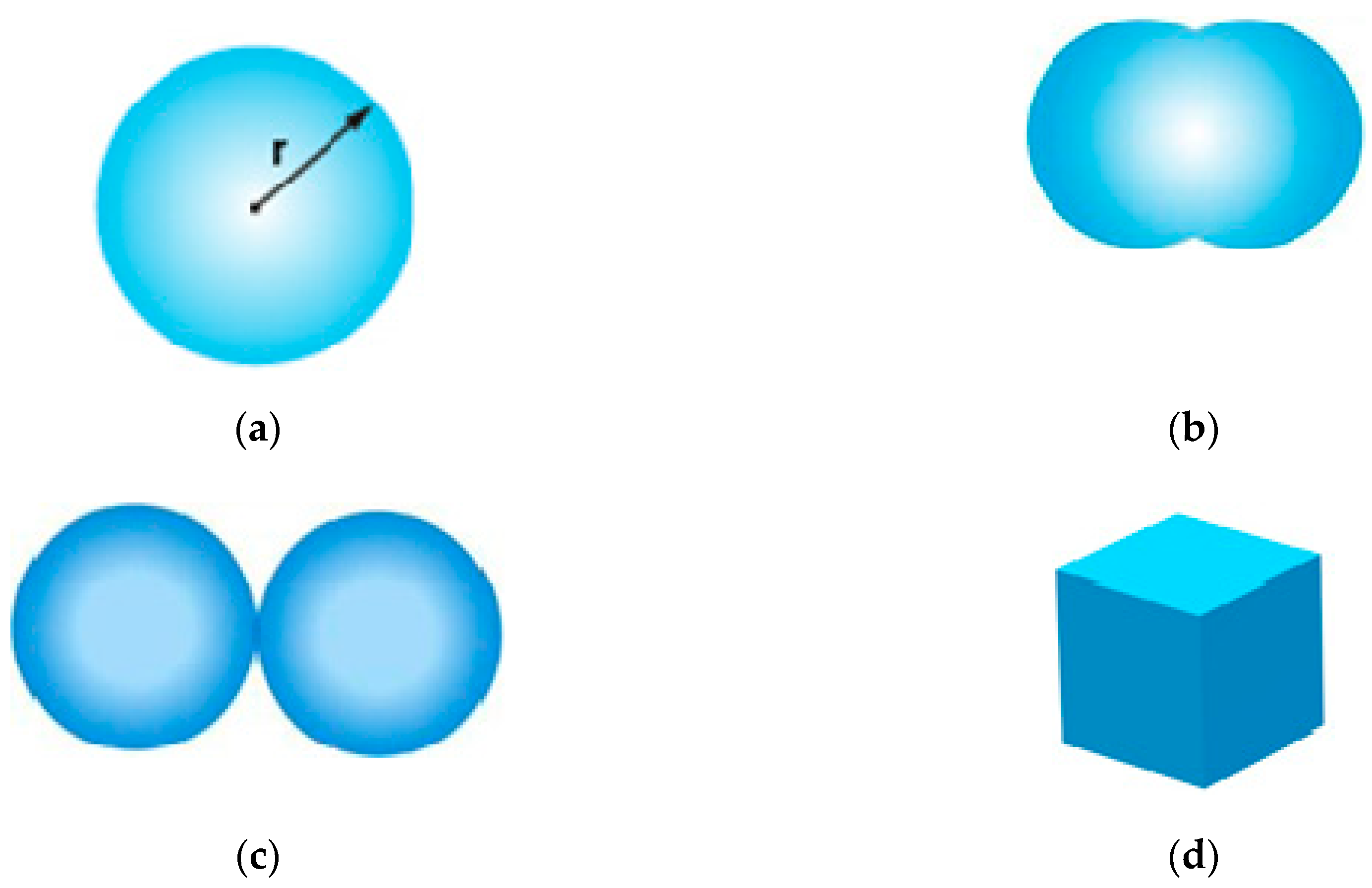
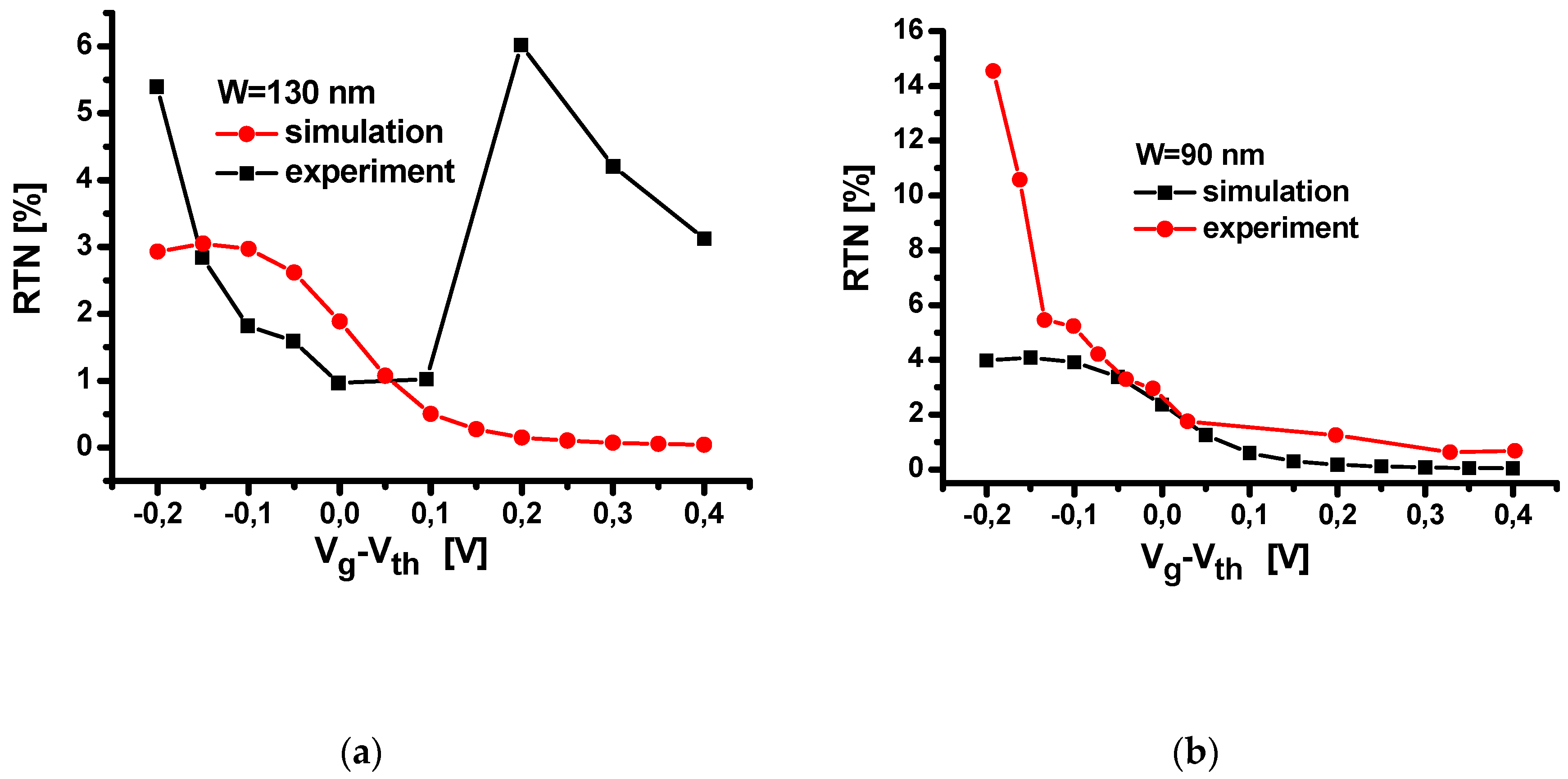

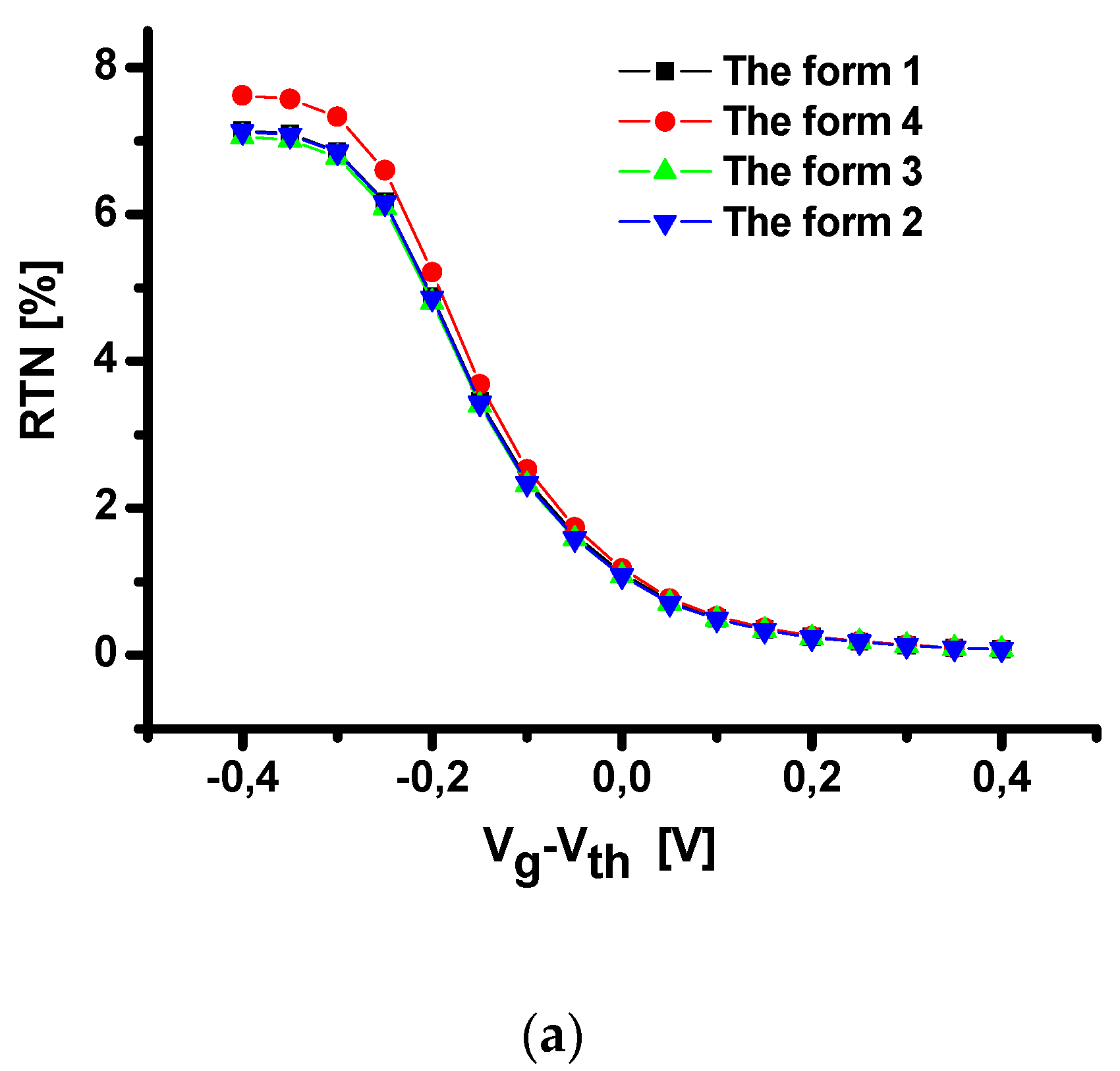
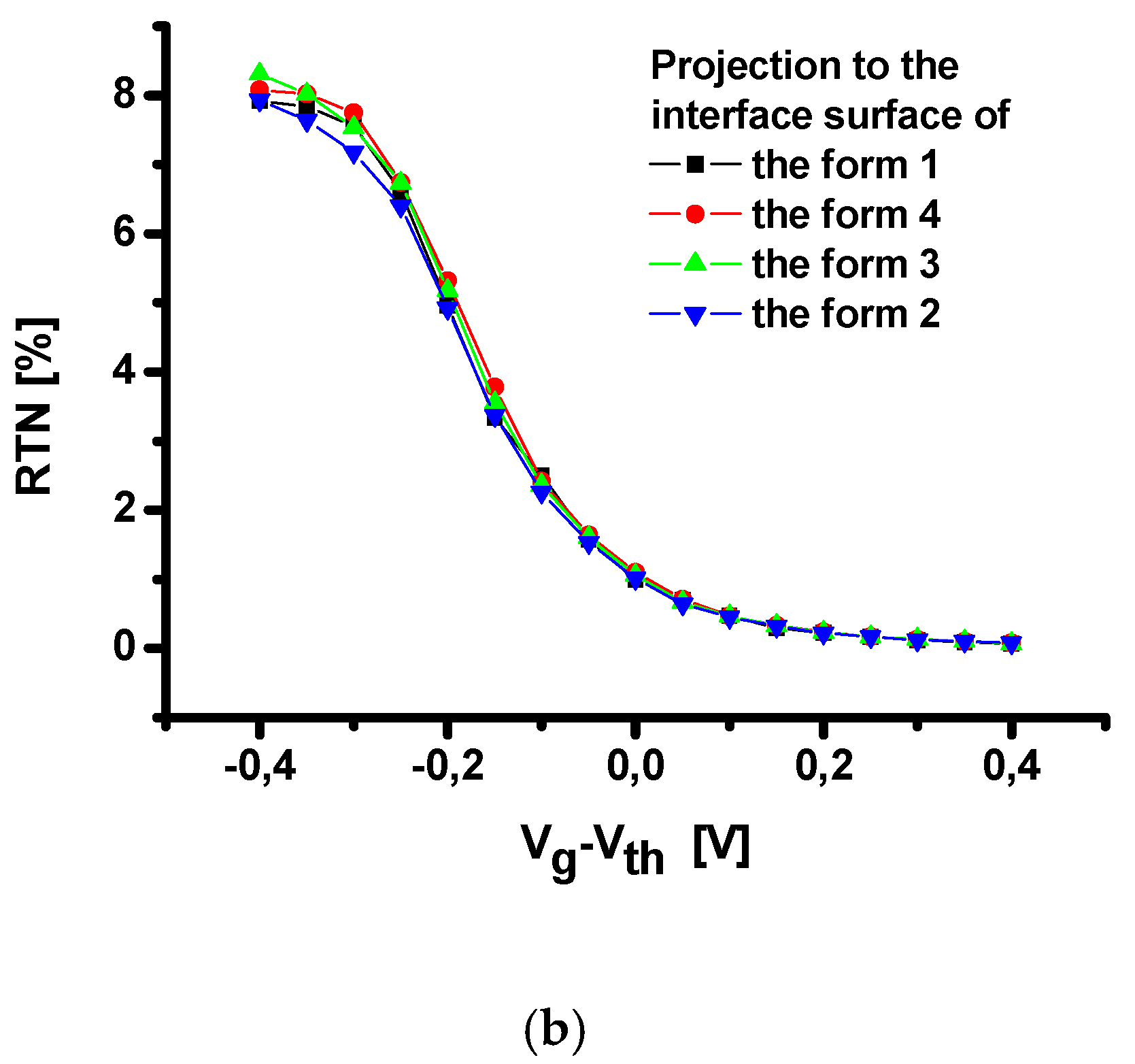
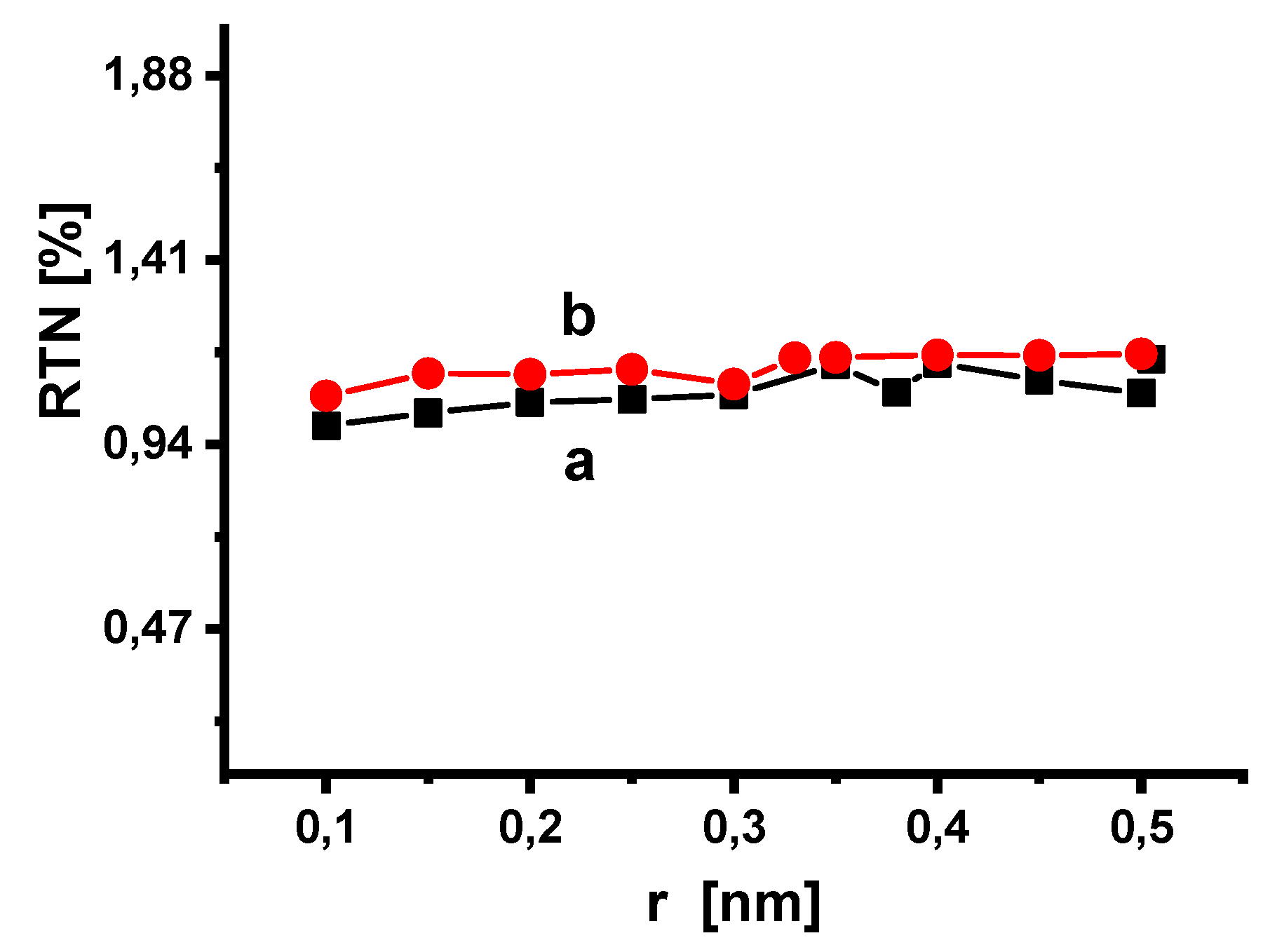
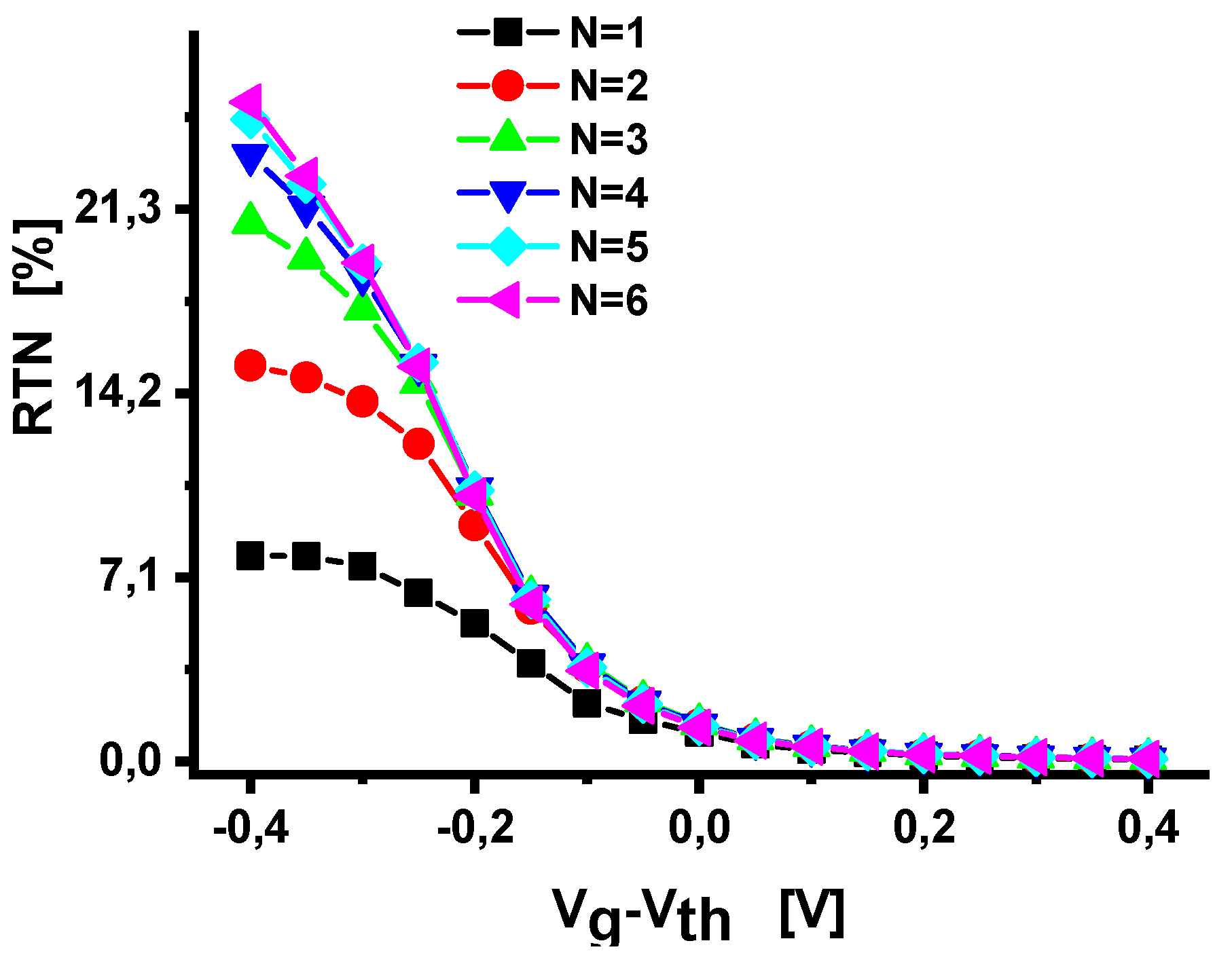
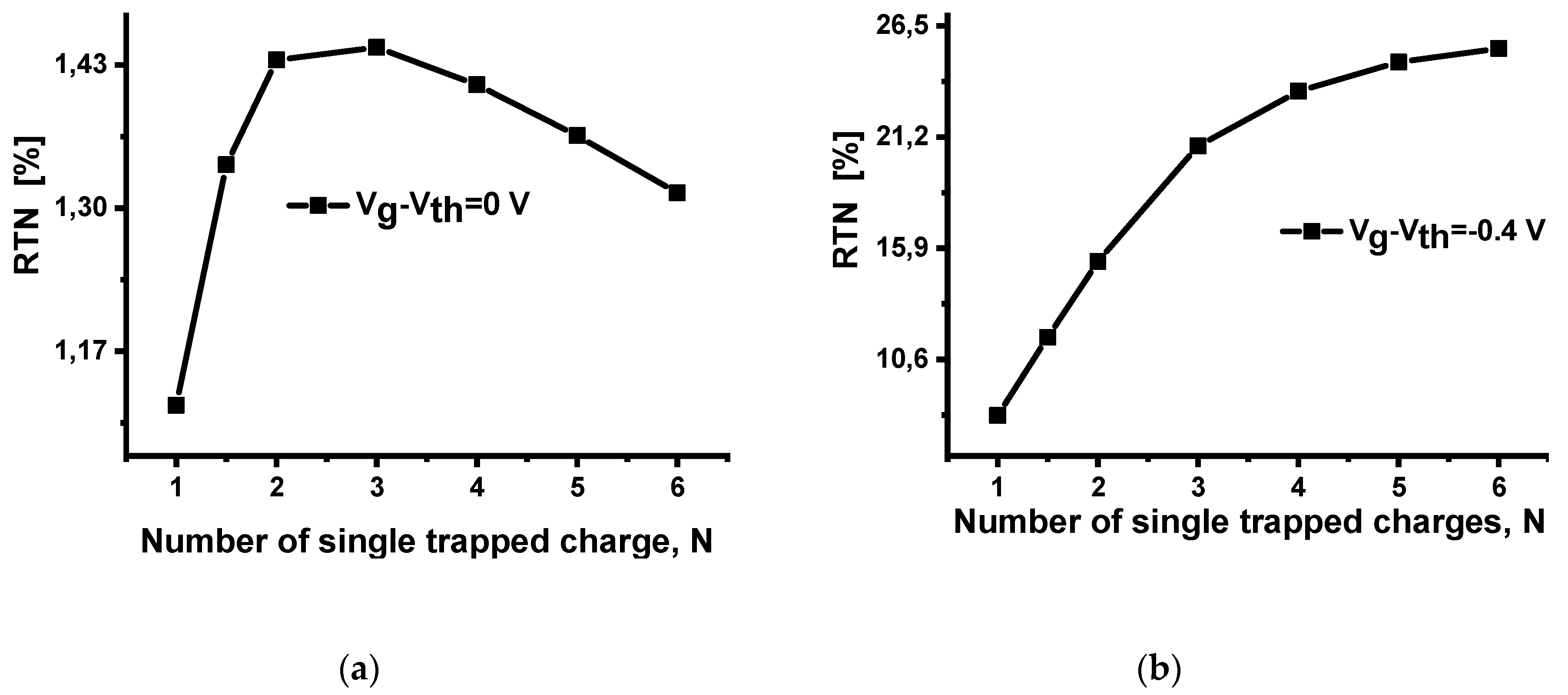
| Parameters | Designation | Value of the Parameters |
|---|---|---|
| The channel doping concentration | Nch | 2 × 1016 cm−3 |
| Gate oxide thickness | tox | 1.4 nm |
| Gate width | Wgate | 90, 130 nm |
| Gate length | Lgate | 55 nm |
| Parameters | Designation | Value of the Parameters |
|---|---|---|
| The channel doping concentration | Nch | 5 × 1018 cm−3 |
| Equivalent gate oxide thickness (HfO2) | teff | 1.2 nm |
| Channel thickness | Tsi | 9 nm |
| Channel width | Wfin | 22 nm |
| Gate width | Wgate | 55 nm |
| Gate length | Lgate | 13 nm |
© 2020 by the authors. Licensee MDPI, Basel, Switzerland. This article is an open access article distributed under the terms and conditions of the Creative Commons Attribution (CC BY) license (http://creativecommons.org/licenses/by/4.0/).
Share and Cite
Atamuratov, A.E.; Khalilloev, M.M.; Yusupov, A.; García-Loureiro, A.J.; Chedjou, J.C.; Kyandoghere, K. Contribution to the Physical Modelling of Single Charged Defects Causing the Random Telegraph Noise in Junctionless FinFET. Appl. Sci. 2020, 10, 5327. https://doi.org/10.3390/app10155327
Atamuratov AE, Khalilloev MM, Yusupov A, García-Loureiro AJ, Chedjou JC, Kyandoghere K. Contribution to the Physical Modelling of Single Charged Defects Causing the Random Telegraph Noise in Junctionless FinFET. Applied Sciences. 2020; 10(15):5327. https://doi.org/10.3390/app10155327
Chicago/Turabian StyleAtamuratov, Atabek E., Mahkam M. Khalilloev, Ahmed Yusupov, A. J. García-Loureiro, Jean Chamberlain Chedjou, and Kyamakya Kyandoghere. 2020. "Contribution to the Physical Modelling of Single Charged Defects Causing the Random Telegraph Noise in Junctionless FinFET" Applied Sciences 10, no. 15: 5327. https://doi.org/10.3390/app10155327
APA StyleAtamuratov, A. E., Khalilloev, M. M., Yusupov, A., García-Loureiro, A. J., Chedjou, J. C., & Kyandoghere, K. (2020). Contribution to the Physical Modelling of Single Charged Defects Causing the Random Telegraph Noise in Junctionless FinFET. Applied Sciences, 10(15), 5327. https://doi.org/10.3390/app10155327







